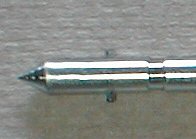Replacing the rubber endpin tip on a Kay/Engelhardt or other bass
NEW!
Don't feel like seeking out and buying a 4-pack of both of these tips, and having three left over? Now you can purchase "Bob's Rubber Endpin Cover Solution" directly from us as a package, complete with instructions.
We also have replacement endpin covers for Kay and Engelhardt stock 1/2" endpins. They are an upgrade to the stock "crutch-tip" style rubber cap provided by Engelhardt, with a reinforcing washer to protect from tip "poke-through", and have a nice, grippy bottom surface.
Click on over and check it out!
This FAQ will remain here for DIY-ers, even though we now offer this solution as a purchaseable product. The "doubled up" method that Bob advocates below still works great on his own personal Kay bass, and you can purchase the tips below as a kit here on our site, or seek them out elsewhere as we once advocated doing.
I get a lot of calls for replacement rubber tips for the unique Kay and Engelhardt endpins. They are 1/2" shafts, which is unusual in the upright bass world, and for years, when the tip wore out, I bought boxes of crutch tips. They work, but they really don't last that long, so I was always in search of a better solution. For a quickie, you can pick up 1/2" rubber tips at most hardware stores. But I have some alternative suggestions.
But first, an opinion... if you are in an environment where the floor can be sacrificed, removing the rubber tip and digging in with the point can be a good thing for your sound, to couple with the floor. They aren't pointy by accident! In some cases, however, such as a hollow stage with a flexible floor, it may make it more boomy, which may or may not be a good thing. And, obviously, don't dig a little divot into a stage floor without asking the stage manager/venue owner first!
 If you have a contemporary Engelhardt, the endpin may have a crossbar that prevents you from losing the pin inside the bass, as shown in the photo at left. Consider cutting or grinding them off so you can turn the whole post around, and put the pointy end inside the bass and the blunt end outside. Your rubber tips will last a lot longer without that sharp point driving its way into the rubber!
If you have a contemporary Engelhardt, the endpin may have a crossbar that prevents you from losing the pin inside the bass, as shown in the photo at left. Consider cutting or grinding them off so you can turn the whole post around, and put the pointy end inside the bass and the blunt end outside. Your rubber tips will last a lot longer without that sharp point driving its way into the rubber!
Alternatively, some metal washers or a metal disk can be placed inside the tip so the sharp point won't pierce the rubber tip.
My solution for a more robust tip is a simple and inexpensive (cheap Bob!!) one. The larger the tip, the more rubber, so I went to a local hardware store and bought TWO types of tips.
- a 1/2" (13mm) Vinyl Furniture Tip (Ace Hardware ACE 5015623 or equivalent)
- a 5/8" (16mm) Rubber Straight Tip (Ace Hardware ACE 51239 or equivalent)
 The tip shown between the packages in the photo is the original Engelhardt rubber tip, which you can see is smaller. The rubber is also softer.
The tip shown between the packages in the photo is the original Engelhardt rubber tip, which you can see is smaller. The rubber is also softer.
First, slip the slim vinyl 1/2" tip on the pin, and then force the 5/8" rubber tip over it, as shown in the photo at right. This results in a much more robust tip that lasts 2-3 times longer in my experience. I've seen these same tips at other hardware stores, usually in a four-pack, and I seem to remember they ran around $4-6 a pack.
I've also begun to put a metal nut at the base of the first (vinyl) tip, just large enough to keep the sharp tip of the pin from penetrating. I've used a little adhesive to keep it in position in the tip. This makes the whole arrangement last even longer.
This idea can be used on other bass endpins, just adjust the rubber tip sizes to handle your bass, and also see if you can remove and use the dull end of the pin with a rubber tip.
Hope this helps!
Addendum- Adam Tervort suggests checking out the rubber tips used for drum hardware, as they are made of a more durable rubber.
Jeff Lind says, "FYI, Vario hiking poles makes a rubber tip for its sticks that is perfect for a Kay 1/2" end pin shaft. They are better than anything Kay ever sold." Bill Burke also concurs: "The Vario hiking pole tips really do fit the Kay endpin perfectly."
Your suggestions are welcome, too!
Back To: Knowledge Base (FAQs)
